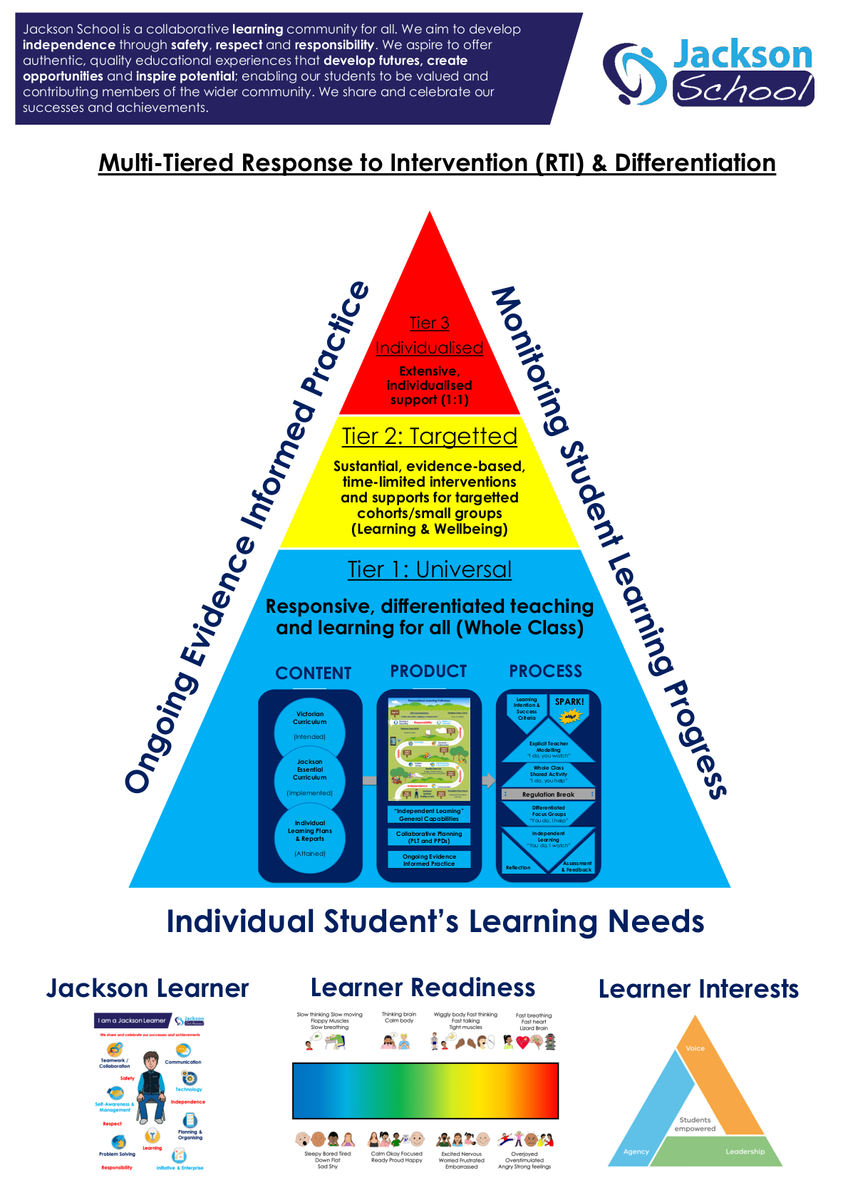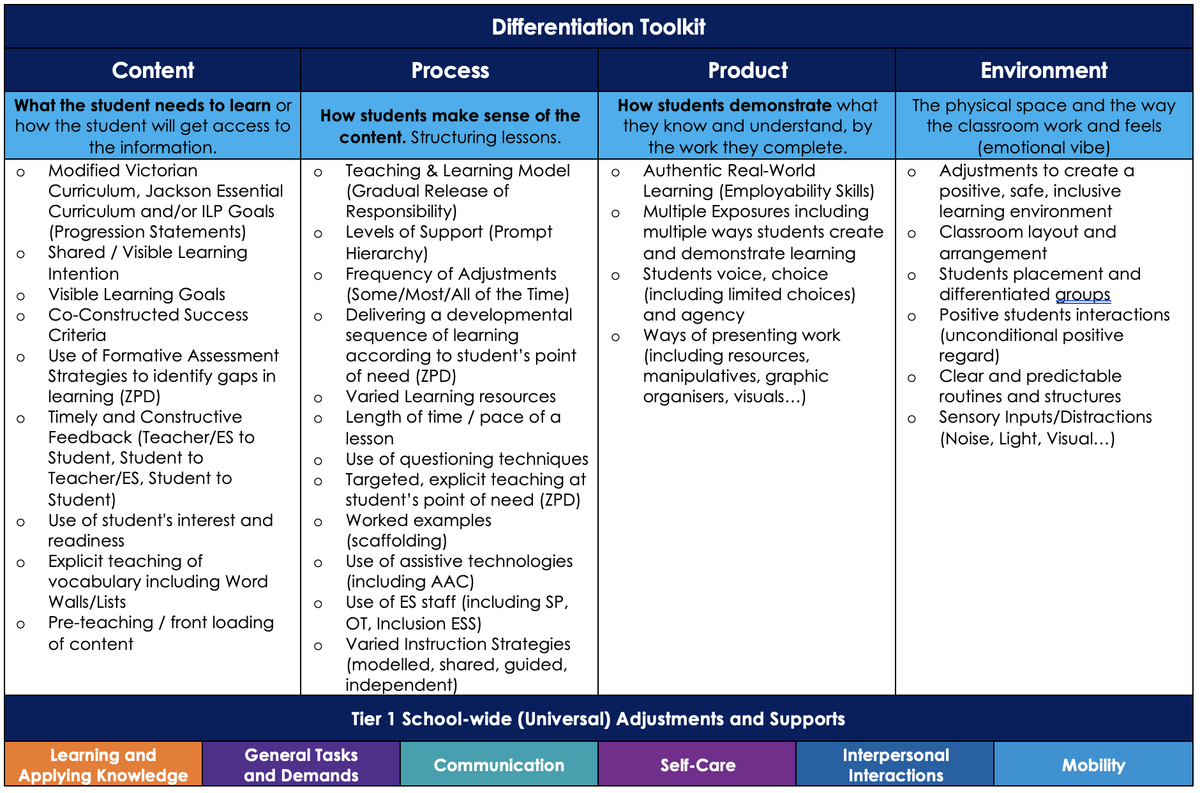Differentiation & Intervention Model
Multi-tired Response to Differentiation and Intervention

Differentiation & Intervention Model
Multi-tired Response to Differentiation and Intervention


Differentiation & Intervention Model
At Jackson, our whole school Differentiation & Intervention Model is built upon the Response to Intervention (RTI, adapted from Buffum, Mottos & Weber, 2012) which is a highly effective, multi-tiered approach of systems and supports (MTSS) to differentiation. This is to support the identification of student’s individual abilities and barriers to learning and the delivery of reasonable adjustments required to meet the individual needs of learners. This is aligned to the Disability Inclusion (DI) and NCCD Levels of Adjustment (differentiation, supplementary, substantial, extensive).
Using a Multi-tierd Response to Intervention (RTI) model is an effective whole-school approach to differentiated teaching and learning practices. RTI relies on primary prevention through the provision of consistent, quality differentiated teaching practices for all students, followed by evidence-based learning interventions to address learning gaps for some students.
Vulnerable groups of learners at risk of disengagement will require adjustments at all tiers. Teachers should use the Jackson Learner Dashboard to know and understand the contextual groups of learners in their cohort.
An education provider is required to make any decisions about admission, enrolment or participation on the basis that reasonable adjustments will be made where necessary so that the student with disability is treated on the same basis as a student without the disability (DSA, 2005). Differentiation also describes provision of reasonable adjustments for students with learning difficulties and disabilities. Adjustments should take account of student knowledge and skills, and what they need to learn next based on the Victorian Curriculum. Adjustments can include individualised and small group targeted learning interventions (in class and withdrawn) for some students when learning gaps are evident.
Differentiation starts with knowing your students, in particular their learning skills and current capabilities, as well as their passions, motivations and interests. The cultural perspectives and social emotional readiness are additional factors to consider.
Universal and Environmental Adjustments are also influenced by Thomlison (2000) work on Differentiated Instruction (DI). Teachers can differentiate at least four classroom elements based on student readiness, interest, or learner profile: Content – what the student needs to learn or how the student will get access to the information; Process – activities in which the student engages in order to make sense of or master the content; Product – culminating projects that ask the student to rehearse, apply, and extend what he or she has learned in a unit; and Learning Environment – the way the classroom works and feels.


Finally, differentiation works best when teachers create a climate for learning that is inclusive, safe and responsive. This approach maximises emotional, cognitive and behavioural engagement. Learners at risk of disengagement can be at any stage of schooling and there are many factors that may contribute to a child or young person becoming or being disengaged. These include family and community factors, personal factors such as physical, mental health or behavioural issues, as well as school-related factors.
Teachers must demonstrate knowledge and understanding of strategies for differentiating teaching to meet the specific learning needs of students across the full range of abilities.
Differentiated teaching are methods teachers use to extend the knowledge and skills of every student in every class, regardless of their starting point. The objective is to lift the performance of all students, including those who are falling behind and those ahead of year level expectations.
Tier 1 (Universal) – 85%
Universal, environmental adjustments with supplementary Quality Differentiated Teaching & Learning (from DIP and NCCD). All students are entitled to responsive, differentiated teaching with High-Impact Teaching Strategies at Tier 1. Within Tier 1 teaching some students may be taught in small guided focus groups or in a one-to-one situation to support their learning as part of the Jackson Teaching & Learning Model. Teachers are often skilled at differentiating their teaching to suit differences in learning. Where a child has difficulties that cannot be met within the Tier 1 provision they can be given additional help and support at Tier 2 or 3.
Tier 2 (Targetted) – 10%
Targeted, time-limited small-group interventions (in class and withdrawn) and supplementary adjustments. Small group work (occasionally 1:1) usually delivered by a Teacher or ES. Students chosen for Tier 2 support are those who are slightly behind their peers and can ‘catch up’ with the rest of their group. The school will make a decision as to whether the child could benefit from Tier 2 support. The decision is based on how well the student is doing and how far behind they are compared to their peers. Tier 2 interventions last a specified number of weeks (6-20 weeks), and by the end of the intervention students in the group should have caught up or be ready to be engaged in their learning for longer periods of time. The pace and duration of intervention will depend on the group of students (ideally 30 minutes, 3-5 times per week, 1:3). The child who has greater difficulties in literacy/numeracy and who is unlikely to catch up with their age group through a Tier 2 intervention should be given an intervention at Tier 3. Tier 2 should not be seen as a stepping stone to Tier 3 intervention and be taught in addition to quality Tier 1 practices.
Tier 3 (Individualised) – 5%
Student Agency in Learning
Students can become agents in their own learning when teachers engage them in the learning process.